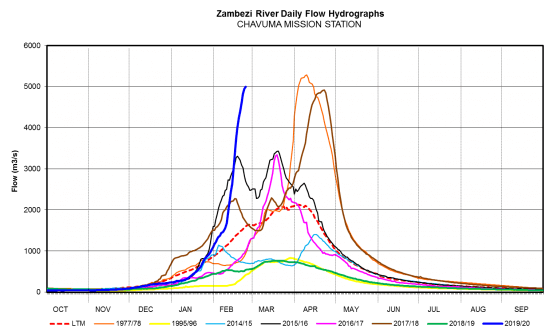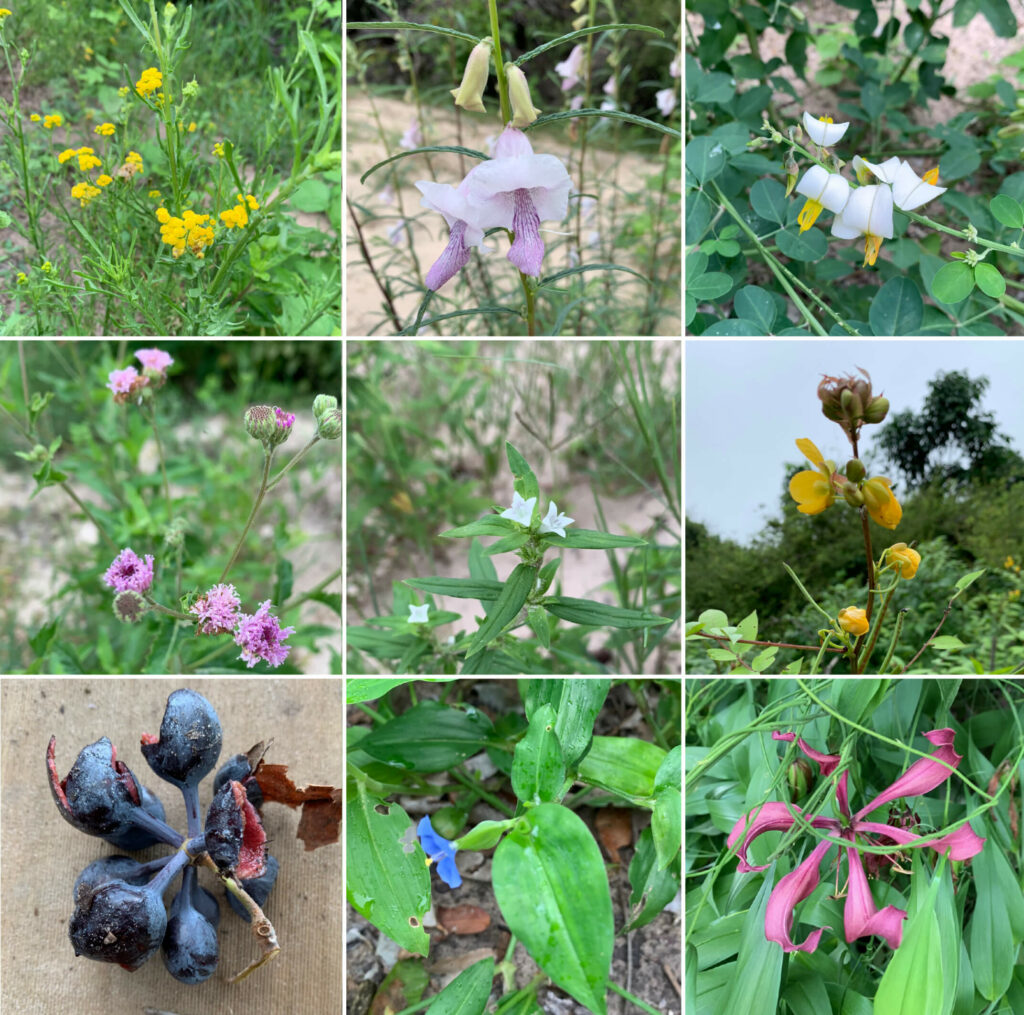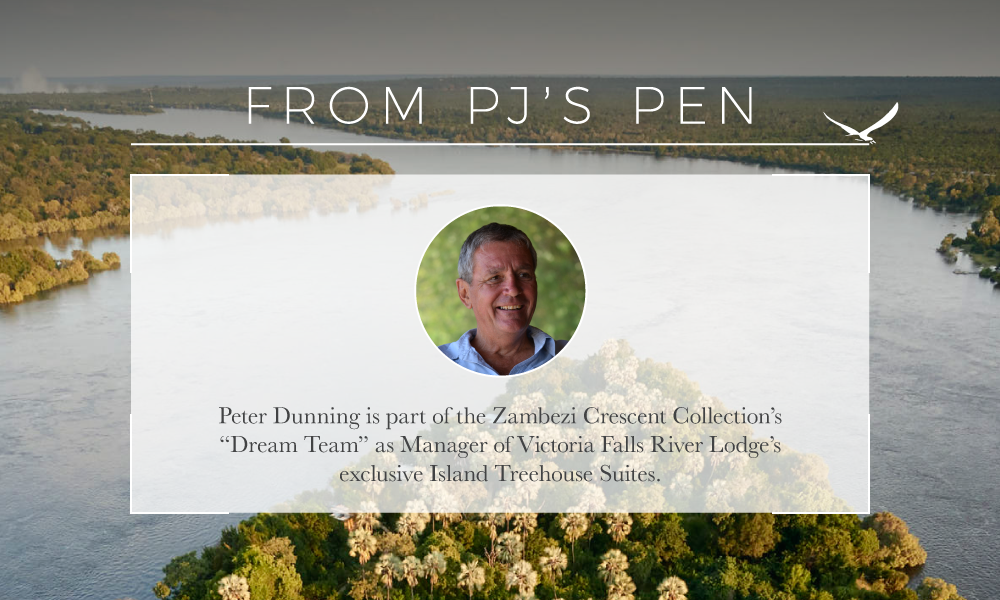February is an interesting month here; it is typically the season during which we should receive the highest rainfall of the whole year and it is, correspondingly, the month of the year with the lowest guest occupancy. It is also the month when our staff can use up their untaken annual leave.
This year the rains settled in over the lodge early on, and we’ve had 142mm in a week. Last season we had 73mm in six days, and the 2017/18 season yielded 400mm in three weeks, with no rain on only 5 of 21 days.
The Zambezi has turned chocolate brown, the dirt roads in the park get very washed away, and our staff bus must sometimes wait for an hour or so as flash floods block roads.
The little feeder rivers between us and town only flow a few times every year, but they can get impassable surprisingly quickly. In Namibia, they use a lovely English word in calling them “ephemeral rivers”.
On 10 February the volume of water flowing through the measuring station at Chavuma in Zambia was 1,683 m3/s. On the same day last year, it was only 542 m3/s, so three times the amount of water is on its way to us, not including run-off between Chavuma and Vic Falls.
By 17 February the disparity in volume at Chavuma was even greater; 3,761 m3/s this year vs 504 m3/s last year.
And on 24 February the volume at Chavuma was 4,994 m3/s against 542 m3/s. This is nearly ten times the volume, so it’s going to get interesting by April/May.

Pools form in the riverbeds, and it is here that we find the Serrated Hinged Terrapin making the most of favourable conditions. These reptiles feed on frogs, tadpoles, and carrion, and the adults will take ticks off animals that come down to drink. In 2016 I witnessed a terrapin successfully ambush, kill, and eat, a dove that was drinking at the water’s edge.
The generally cloudy conditions are much liked by the resident hippo population, who spend more time out of the water during daylight hours.

On 24 February we received 66mm of rain on the Island, the most recorded in one day since we built the lodge here. It started with a mega thunder and lightning show at 2.00 am and only stopped just after lunch. Some parts of the town of Victoria Falls recorded 125mm, which is an astonishing amount of rain for this part of Africa. On 26 February the seasonal total was just shy of 400mm, and by only received 340mm last season. The rains here should continue to early April.
By this stage of the rainy season, we are inundated with wildflowers on the island. In a ten-minute walk yesterday, I photographed nine different plants currently in flower on the island.

Individual identification is challenging, but there is one wildflower that everybody knows about Tribulus Terrestris, also known as the Devil Thorn. It grows on disturbed areas and sandy soils along roadsides and in grassland.
Tribulus is literally forming a carpet on both sides of the road to town, as far as the eye can see. It is poisonous to livestock, causing liver damage, so no wild herbivores will eat it.
The plant produces lots of very spiny little thorns which render barefoot walking impossible. Every kid in Zimbabwe has picked these little menaces out of their feet at some point.

The purple hook-berry (also known as the large hook-berry) is usually found in riverine vegetation, sometimes in dry woodland, at low and medium altitudes.
There is plenty of it on the island, and in February it comes into fruit. There is a huge liana of it hosted by a giant ebony above my tent, and Trumpeter Hornbills come to feed on the fruits, which look a bit like baby figs.
Our Banded Mongoose population suddenly expanded by 12 in early February, which caught everybody by surprise. We got our first glimpse of the new babies at afternoon tea on 11 February. As their numbers increase, it becomes almost impossible to count them all accurately. They had a litter in February last year too, which possibly indicates that they give birth when food supplies are at their optimum.
Every year at around this time we welcome two very special guests from Iowa City. Bob Brooks and Mark Ruggerberg arrived this year on their fourth visit to River Lodge. They always have Faithy as their Guide and have formed wonderful relationships with him and Senzie, our Front Office Manager. In 2017 they visited the Rose of Charity Orphanage in Victoria Falls and were so touched by the needs of the kids there that they now pay tuition fees every year for 23 children. They are long term and committed Rotarians back home, so charity is a deep passion for them both. Bob and Mark have a particular interest in early education because they believe that nothing else has quite the same potential for change in the world, especially for girls.
This year they visited the pre-school that we built at the entrance to Zambezi National Park to cater for the children of National Parks employees. When they saw the teacher showing the little kids videos on her phone, they immediately went to town and bought a brand-new TV for the school.
They handed the TV over to the teacher on 14th February. A different and truly powerful way to celebrate Valentine’s Day, and we are truly overwhelmed by their generosity. Bob and Mark own and manage The Brown Street Inn in Iowa City.




